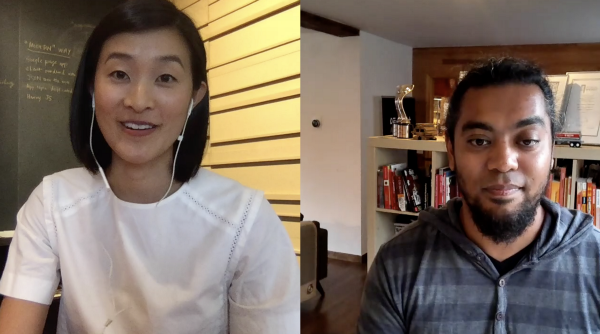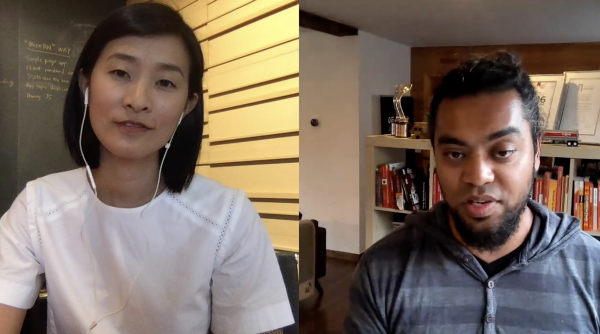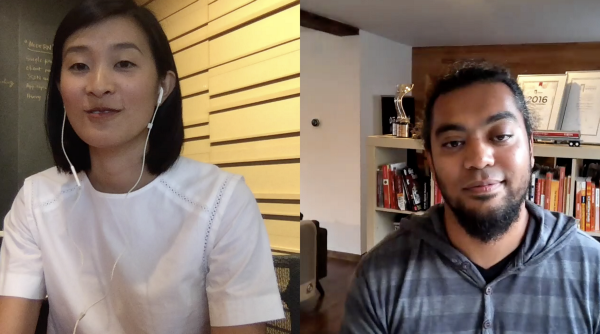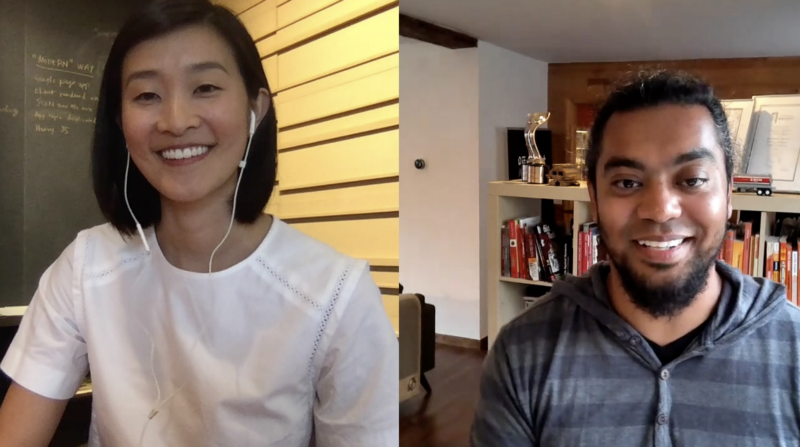As a creative leader who’s worked with everyone from Apple to ESPN, Dan shares his biggest leadership lessons on servant leadership and how to ensure teams work well together.
Claire: Hi everyone. I’m Claire Lew and I’m the CEO of Know Your Company. Today, I’ve got a good friend of mine with me that I’m so excited to have on The Heartbeat. His name is Dan Mall and he’s the co-founder of SuperFriendly which is this amazing design collaborative. They’ve done work with in everyone from Apple to Time Magazine to ESPN…kind of the dream client list.
But not only is Dan just this amazing creative designer and leader, bringing creative teams together, but he also recently founded SuperBooked which is this really cool app that helps people find creative work. So, Dan’s been a leader in the design field on a lot of different respects. He also runs a nine-month apprenticeship program who teach people who want to get into design how to do so, make a career in that.
He’s published a book on pricing. I’m just really excited to have Dan here and to ask him this one question about leadership.
Dan: Thanks, Claire. I’m ready.
Claire: All right, you ready? Let’s do this. So, the question I’d like to ask you Dan is…
What’s one thing you wish you would have learned earlier as a leader?

Dan: That’s a good one. That’s a tough one.
Claire: It doesn’t have to be one thing. Some people are like, “Oh boy.” All right. Yeah. We can start anywhere.
Dan: What I wish I would have learned earlier as a leader is that leaders, the stigma of leaders tends to be at the top of the org chart, right? The leader is the one at the very top. What I’ve learned recently that I wish I’d learned earlier is that the leaders aren’t the ones at the top. They should be the one at the bottom. They should be the one supporting everyone else. So, I heard the analogy that when you think about the general of an army, in movies, they’re the ones all the way in the front. They’re the ones leading the charge, but actually generals are the ones in the back. They need to have purview. They need to be able to see everything. They need to be able to support people. They need to be able to orchestrate.
I like the idea of flipping the org chart to say that the leader should be the person at the bottom, supporting everyone moving the pieces up, holding everybody up if they can’t support their own weight.
So, I wish I would have learned the idea of servant leadership which is becoming more and more popular now. It’s a fairly new concept to me over the last couple years. I’m trying to learn as much as I can about it, but I wish I would have learned that earlier.
Claire: Absolutely. I think the “general” metaphor in particular actually kind of hit close to home. My grandfather, actually on my dad’s side was a four-star general in the Korean army.
Dan: Oh wow.
Claire: Yeah. So, when I think about leadership I actually think about him first and foremost. Forget folks in business — I think about my grandfather. I think you’re so right. That we have this preconception in our heads that leaders, they’re at the top. The triangle is kind of like this and they’re at the top of that chart. And you’re so right, it should be flipped the other way. I think that’s brilliant.
So, for you Dan, you said that you’ve been feeling this and learning this rather recently. So, has something happened? Did you read something? Did you have an experience with your team where you went, “Oh boy. I gotta start thinking about this differently?”
Dan: So, for me it was definitely a book that I read that I didn’t expect much out of. So, Simon Sinek wrote a book called Leaders Eat Last. Everyone knows Simon Sinek by his TED Talk and by his Start With Why book and that seems to be the most popular one, which I read and loved. Then I read Leaders Eat Last and I loved it way more. I hadn’t heard as much about that book so less spoilers for me I guess. When I read that book, just if I can give the premise of that book. It’s about the physiological things that happen when good leaders enable their teams. So, there’s a lot that happens in your body chemically that actually are imbalanced in typical workplaces, especially in tech where people don’t get the support that they need and so they act a certain way.
So, he goes through kind of the science of leadership and of team building and of being on a team and how good leaders can actually enable the right chemical makeup on their teams. It’s really fascinating. When I read that book, it kind of changed my perception of what a leader is supposed to do evolutionarily and chemically and things that I never would have occurred to me. So, that book was really impactful for me in thinking about leadership.
Claire: That’s awesome. I’ve actually heard nothing but good things about the book I’ve still yet to read it. Obviously respect Simon Sinek a lot. So, then, have you maybe tried to put some of these practices day to day, whether it’s SuperFriendly or SuperBooked?
You’re in a really unique leadership role for folks who don’t understand the work that you do with SuperFriendly is that these are folks who are not … It’s sort of like the best of of a team that you’ve assembled, but they don’t necessarily work for you and yet you’re the leader. So, whether it’s that, whether it’s in building your own piece of software, how have you tried to put those words into actions or those ideas into action?

Dan: So, there’s two ways. One comes from that and then one comes from another book which I’ll tell you about in a minute. So, the first way is the way that I’ve tended to start all my projects recently is get everybody in the same room physically if we can or if not, on video chat at least. Just ask everyone what would you like to do on this project? Devoid of your role, if you’re a developer, it doesn’t have to be development. If you’re a designer, it doesn’t have to be about design, but what do you want to grow in?
I try to make clear that my job on the project is to help you grow in that thing.
So, if you’re a designer and you want to learn more about Angular, cool. Let’s use this project as an excuse to learn Angular or if you’re a producer and you want to do more illustration work, great. Let’s find and opportunity for this project on this project for you to do illustration work. My job as the director on the project or as the creative director or whatever my role is is to make the space for that and make it okay if that doesn’t actually work out. So, yeah. You want to learn Angular. If you decided Angular’s too difficult for you or you just don’t like it, that’s fine. No harm done to the project and my job is to kind of protect that.
So, that’s one piece. The second piece comes from the book Turn The Ship Aroundby David Marquet which I just read recently. It is an excellent book.
The thing that I’m trying to put into practice now is the idea that the people with the most knowledge is where the authority should go.
So, often leadership is flipped where authority is at the top of the org chart and the knowledge is at the bottom of the org chart, right? The “worker bees.” They have the knowledge but they don’t have the authority to make decisions. So, in that book a lot of that book is about how you shift the authority to the people who have the knowledge and David Marquet gives a bunch of examples of how he’s done that being a Navy captain.
So, one of the things I’m trying to practice more and more which is more difficult is who are the people that have the knowledge and what can I do to say, “No. No. You make the call and whatever call you make, I’ll support you in that.”
That’s tough for me because running a consultancy, it’s my name and my reputation on the line so it’s hard to relinquish that and say, “Oh, no. No. You make the call. It’s totally fine.” Especially because I’m the kind of guy who thinks that I know everything and I know best. So, it’s hard to relinquish that, but it’s something that I’m trying out. So far, it’s been really great in the instances that I’ve tried it. So, I’m going to try to do it more and more.
Claire: You, me, and everyone else, Dan, trying to relinquish that control. It is hard. It is easy to read it in a book. It is compelling in a book and it is so hard in practice. I want to go back a little bit though to what you had mentioned in the first part which is this question that you like to ask your team before you kick off a project which is: “Where do you want to grow in?”
I think that question is one of the most overlooked questions for managers and leaders in thinking about that really the greatest source of motivation for employees is them making progress on any work and so asking how do they want to make progress? How do they want to grow in? In this case, someone who, again, they’re not working for you technically in this situation. So, I love that insight.
Then, yeah. You talking about relinquishing control. Man. You said a little bit of you have a tendency to not want to give up that control in that your name’s on the line. What do you tell yourself in that moment when you feel like do I want them to make the call? Should I just step in? What sort of thing is going through your head at that moment?

Dan: So, I’ve got a really good privilege on my side which is that I’ve worked on a lot of projects.
So, I’ve been doing what I’m doing for 15 years or 18 years or whatever it is. I’ve lived through every kind of project. Really terrible ones, really good ones and the common thread is how happy we were on projects.
That’s the thing that how did I feel on the project? How did my team feel? If we felt great, then it’s a successful project regardless of the quality of the work. So, I’ve always thought that the quality of the work is what counts. I think that there is a lot to be said for doing work at the highest quality or at the best of your ability. I think that’s how people grow is by stretching themselves in that way, but I also think that it’s about working with people.
It’s cliché, but on my deathbed, I’m not going to be like, “Man, those Photoshop files weren’t that good,” or I think-
Claire: Really? You sure?
Dan: Well, I don’t know. I don’t know. I’ve never been on my deathbed so we’ll see. I’ll tell you if it changes, but I think that I’ve had the best time on projects when we are having the best time. Regardless of the work that we’re doing. Then as a coincidental side effect, when we are having the best time, we do the best work. So, I forget the name of the study that they did, but I think Google’s team did a study on what makes for the best teams. I think this was five years ago. The thing that came out was psychological safety. It didn’t matter the talent of the team. The talent level or the tenure or the experience or any of that. It’s just matters if people feel safe on teams.
Claire: Yes.
Dan: If they feel safe on teams, they will do their best work period. It was pretty conclusive results there. So, I’ve really tried to take that to heart.
Let’s just make a good space for each other. That includes clients. I do client service. Let’s make a good space for each other. I don’t want to work with clients that abuse me or my team. I don’t want to abuse them. I don’t want to have an us and them mentality. I know a lot of client and vendor relationships start antagonistically. Like it’s just, “Oh, they’re a client. They’ve gotta be bad.” I don’t like that. I think that if we approach it in a different way and we are more open minded about it, we’ll have better collaborations and we’ll do better work together.
So, I try to start off my projects … I’m in a lucky position now where I’m in control of these projects so I can actually shape them the way that I want to.
Claire: Yes.
Dan: So, I find that I have the best time. It seems like my teams have the best time when we start with, “What do you want to do?”
One last thing. One last thing from that book Leaders Eat Last, there was one anecdote that he shared where there was a company that basically said you will not get fired. No matter what you do unless you do something against the code of conduct essentially at the company we’re not going to fire you. He said that that changed the dynamic of the company so much because when somebody does poorly, the response is not, “Well, they’re going to get fired.” Their response is, “What can we do to enable their growth?” Have they not learned a particular thing that we can get training for them or do they need more support in this area? But when you take firing someone off the table, it changes the dynamic of the whole team.
So, that was something that kind of stood out for me was like, “Okay. If I think about I’m not going to get fired or I can’t fire someone or this person is not going to get let go, how does that change how I actually work with them? It really dawned on me. That’s family. I can’t fire my brother if I’m upset at my brother. I can’t fire my dad or my wife or my kids. I have to learn how to grow with them. So, if we’re really going to talk about how to work together, at some level I spend more time with my coworkers than I do my kids some weeks. So, how do I treat them like my work family and how do I treat them in a way that respects them as people and not just as coworkers or talents or roles or whatever? I feel like that really enables growth for them and for me too.
Claire: Absolutely. I think the point you make about the way that you feel about your work affecting how well you do your work. If you have safety, if you have happiness, if you actually are just feeling good, that everything else falls into place. Yeah. If you don’t have this anxiety that you’re going to get booted and so creating an environment like that as leaders, I love that reminder to do that. So, thank you so much for your time, Dan. This is awesome. Love getting to chat with you.
Dan: Yeah. Thanks for having me.
Claire: Yeah. Take care.

